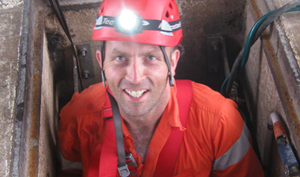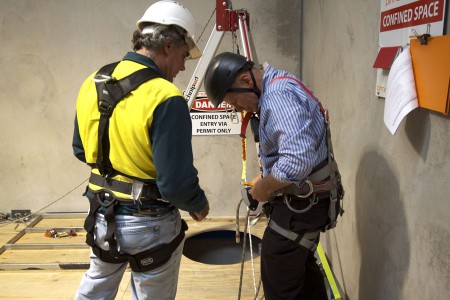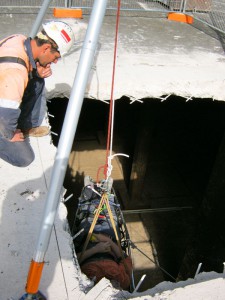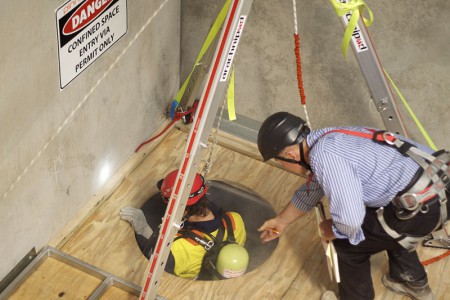No region selected
Confined Space Entry - 2 day
MSMWHS217 - Gas test atmospheres
MSMPER300 - Issue work permits
MSMWHS201 - Conduct hazard analysis
MSMPER200 - Work in accordance with an issued permit
Face to Face
This two-day course covers not only the basic confined space entry skills, but also more advanced confined space training including gas testing, hazard analysis, and the issuing of confined spacework permits. 100% face-to-face training.

Course Dates
| Location (Central QLD) | Start Date | Places Left |
|---|---|---|
|
For group bookings please call us on 1300 990 810. |
Course Details
Certification
Students who are deemed competent will receive a Statement of Attainment recognised under the Australian Qualifications Framework. This certification is nationally recognised. The Statement is issued by Pinnacle Safety and Training (RTO 40496).
National units of competency
- RIIWHS202E - Enter and work in confined spaces
- MSMWHS217 - Gas test atmospheres
- MSMPER300 - Issue work permits
- MSMWHS201 - Conduct hazard analysis
- MSMPER200 - Work in accordance with an issued permit
Course Details
Course duration: 2 days (approximately 8 hours per day)
Up to 12 trainees per course
Price
- $350.00 pp for public courses
- For group bookings outside our public course schedule or at your location, please submit your group booking enquiry here for an obligation free quote.



Course Overview
“Should I do the 1 day course or this 2 day course?”
Our Confined Space Entry 2 day course is for:
- Anyone who wants a greater depth of knowledge of working in confined spaces
- Anyone with a hands-on role in the hazard analysis and risk assessment aspects of confined space operations
- Anyone who may have to act in the role of standby person
- Anyone who wants to be able to issue confined space work permits
- Anyone who may need to supervise other workers during confined space operations.
This course covers everything from our regular Confined Space Entry 1 day course, with an extra day for the content and practical activities relating to roles and responsibilities of the team and the confined space entry permit issuing process.
General Overview
This nationally recognised training course is designed for people who work in or around confined spaces. Pinnacle have been training confined space in Gladstone for nearly 10 years, and this course is tailored to the major Gladstone site-specific training requirements focusing on the safety procedures and practical scenarios relevant to the typical confined space operations on Gladstone sites. While there is a standard set of learning outcomes for the course, we understand that the context and environment in which the learning is applied is varied. It is designed to teach participants how to:
- Identify and control confined space hazards
- Work safely within confined spaces
- Review and assess a range of confined space permit applications
- Issue entry permits for confined space operations
- Undertake gas testing procedures and interpret readings
- Monitor compliance with issued confined space permits
- Address and report non-compliances with permit conditions
If you need to be able to undertake confined space rescue, please see our Confined Space Rescue course.
Employers having a group of employees who have completed this course within the last 24 months may be eligible for our Confined Space Refresher program. Find out more here.
What is a Confined Space?
According to the Safe Work Australia Code of Practice, a “confined space” means an enclosed or partially enclosed space that:
- is not designed or intended primarily to be occupied by a person; and
- is, or is designed or intended to be, at normal atmospheric pressure while any person is in the space; and
- is or is likely to be a risk to health and safety from:
- an atmosphere that does not have a safe oxygen level, or
- contaminants, including airborne gases, vapours and dusts, that may cause injury from fire or explosion, or
- harmful concentrations of any airborne contaminants, or
- engulfment.
Examples of confined spaces include (but are not limited to):
- Storage tanks
- Tank cars
- Process vessels
- Pressure vessels
- Boilers
- Silos and other tank-like compartments
- Pits and degreasers
- Pipes
- Sewers
- Sewer pump stations including wet and dry wells, shafts and ducts
- Shipboard spaces entered through small hatchways or access points, cargo tanks, cellular double bottom tanks, duct keels, ballast or oil tanks and void spaces.
This course is recommended for
Course Outline
- Identifying confined spaces
- OHS legislation, Compliance Codes and Australian Standards relevant to confined spaces
- Roles and responsibilities of management and employees
- Hazard identification, risk assessments and hierarchy of controls
- Issuance of confined space permits
- Work site policy and procedures
- Isolation procedures
- Atmospheric monitoring and gas detection
- Working at height and fall protection equipment
- Safety and emergency procedures
- Practical entry into a confined space
Currency of Training
Australian Standard AS2865 recommends refreshing confined space training every 12-24 months.
Course Inclusions
- Two 8 hour days of face-to-face training conducted by an experienced confined space specialist
- Hands-on practical training designed to develop safe work practices
- Knowledge of relevant legislation, codes of practice and Australian Standards relevant to confined spaces
- Recommendations and advice for specialised PPE and equipment for your workplace
- Advice on risk control methods for the type of work to be undertaken
Each Trainee Must Provide
Participants must
- Be at least 18 years of age
- Wear suitable attire (including long pants and closed-in shoes)
- Provide their own lunch and transport
- Have a sufficient level of reading, writing, numeracy and oral communication to undertake this training, including the ability to:
- read and interpret documentation relevant to the confined space entry permits
- write clearly in English to complete workplace forms
- speak clearly and understand verbal communication in English
- understand gas concentration measurements and interpret gas testing results
- explain and respond to a range of workplace scenarios
Equipment
- We supply all equipment necessary for you to undertake training, however we actively encourage you to bring along your own equipment.
- Working at Heights and Confined Space Combined
- Confined Space Entry - Online Theory + Half Day Practical
- Confined Space Entry - 1 day
- Confined Space Entry - 2 day
- Confined Space Permit Issuer
- Confined Space Awareness
- Confined Space Rescue
- Gas Testing Training
- Operate Breathing Apparatus
- Risk Control Training
I wanted to drop you a line and mention how well run the course was. Travis knew his subject, he was easy to understand, his course was very well delivered and we all enjoyed the day.
Colin M. - Melbourne, VIC
AGL
Brett was very knowledgeable and his wealth of experience in the industry was obvious. I have completed many confined space courses over the years and this was by far the best in terms of delivery of the content and the equipment that was used. I will be training with Pinnacle in the future.
Ben S. - Gold Coast, QLD
Public Course ParticipantStudent Links
Dave is a very professional and passionate trainer with a high level of knowledge in confined space training. During my previous 9 years in the industry I can’t think of anyone more passionate about training and safety, including site training officers, safety reps and external trainers.
